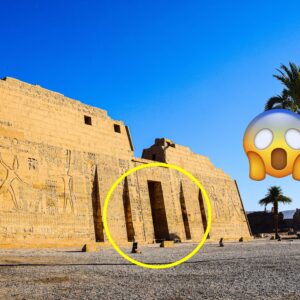A team of archaeologists have discovered a ‘miracle’ structure underneath an ancient Egyptian temple.
The Egyptian Dominican Archaeological Mission were excavating a temple in the ruins of the ancient city Taposiris Magna – located just west of Alexandria, the second largest city in Egypt – when they came across the unexpected find. Headed up by Kathleen Martinez from The University of Santo Domingo in the Dominican Republic, the team dug below the temple, however, when they reached 13 meters (43 ft) deep, they came across an unexpected find.
The Egyptian Ministry of Tourism and Antiquities reveals the archeologists found two-meter (6.5 ft) and 1,305 metres (4,281 ft) tunnel – over 12 football pitches. But what does this all mean? Well, Martinez has been searching for the lost tomb of Cleopatra VII and the tombs of both Cleopatra and Antony have been rumored as being located in Taposiris Magna.

The ancient city is believed to be linked to Cleopatra as it was founded by Ptolemy II in 280 BCE. Ptolemy became Pharaoh after Alexander the Great died and he is one of Cleopatra’s ancestors. The discovery of the tunnel – described by experts as a ‘geometric miracle’ – subsequently acts a promising start in locating Cleopatra’s tomb. The Egyptian Ministry of Tourism and Antiquities’ press release continues: “Two heads made of alabaster were found near the temple, one of which is for a person from the Ptolemaic period, and the other is likely to be a statue of Abu the horror.
“Dr. Kathleen Martins, head of the mission, explained that initial studies indicate that the architectural design of the discovered tunnel is very similar to the design of the Yubilinus Tunnel in Greece.”

The discovery of the tunnel adds to previous excavation findings of ‘important artefacts’ such as coins imprinted with Anthony and Cleopatra’s names and images, as well as statues of the goddess Isis. Taposiris Magna temple’s name means ‘great tomb of Osiris’. Martinez told National Geographic: “Cleopatra negotiated with Octavian to allow her to bury Mark Antony in Egypt. She wanted to be buried with him because she wanted to re-enact the legend of Isis and Osiris. “The true meaning of the cult of Osiris is that it grants immortality. After their deaths, the gods would allow Cleopatra to live with Antony in another form of existence, so they would have eternal life together.”
Former head of Egypt’s Supreme Council of Antiquities, Dr Zahi Hawass, said at the time if the tunnel does lead to Cleopatra’s tomb, Martinez and her team’s work could be ‘the most important discovery of the 21st Century’.
However, further work is needed, with part of the tunnel submerged in water and the team now looking to explore the Mediterranean Sea for parts of the temple which were swallowed up when earthquakes previously hit the coast.
Either way, Dr Hawass concludes: “If we did not discover the tomb of Cleopatra and Mark Antony, we [still] made major discoveries here, inside the temple and outside the temple.”








